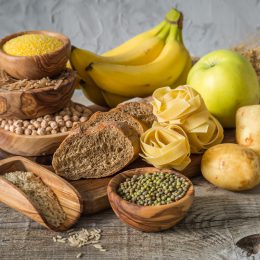Want to Eat Healthier? Here’s What to Do First
These four simple tweaks can make a big difference.

If you have access to the internet, a TV, or even a local newspaper, you know there’s a tremendous amount of healthy eating advice swirling around. Separating the good from the bad from the downright dangerous can be overwhelming. But here’s the thing: Eating for better health and vitality doesn’t need to be nearly as complicated as headlines may lead you to believe.
“As we grow older, change is more difficult, as many of our patterns are set,” says Nancy Farrell Allen, M.S., R.D.N., a spokesperson for the Academy of Nutrition and Dietetics. “So making drastic eating changes, an all-or-nothing approach, or swinging the food pendulum from one extreme to the other can lead to frustration, or even illness, and lower chances of lasting success.”
If you want to improve your diet, making just a few changes that are easy to implement and sustain is a much better approach, Farrell Allen says. The four steps below are a great place to start. They’re not only highly recommended by nutrition experts — they’re also backed by scientific research as effective ways to make lasting, positive changes to your health.
Diet Tweak #1: Relearn Proper Serving Sizes
Whatever your goal — to lose a few pounds, maintain a healthy weight, or make sure you’re eating enough of the right foods — having a solid grasp of proper serving sizes can help you get there.
“Monitoring serving sizes brings about an awareness that makes us more mindful about our eating behaviors,” Farrell Allen says. Plus, with all the supersized quantities of foods and drinks being served these days (at home and in restaurants), many Americans have a skewed perception of what a proper serving really looks like. That’s why relearning the recommended serving sizes for various food groups can be so valuable.
Here are the basics you should know, according to the American Heart Association:
- 1 serving of meat (lean beef, pork, poultry, or fish) = 3 ounces, or about the size of a standard deck of playing cards
- 1 serving of cooked grains (rice, pasta, or cereal) = ½ cup, or about the size of the palm of your hand
- 1 serving of vegetables = 1 cup of cut veggies or 2 cups of leafy salad greens
- 1 serving of fruits = 1 cup of cut fruit or 1 medium whole fruit
- 1 serving of dairy (milk, yogurt) = 1 cup
- 1 serving of dairy (cheese) = 1 ounce, or roughly the size of a pair of dice
- 1 serving of fats (oil, butter, or mayonnaise) = 1 teaspoon, or about the size of a postage stamp
It’s important to note that serving size and portion size are not the same thing. Serving size is the recommended amount of a particular food, while portion size refers to the amount you actually eat in a sitting. In other words, you may eat more than one serving of a particular food group in a meal, or less than one in another. That’s fine. Simply being aware of recommended serving sizes, along with how many servings of each food you need per day, ultimately helps with portion control, Farrell Allen says.
Your action plan: For the next few weeks, make a point to pay attention to the serving sizes you dish up. It will quickly reveal where you may need to scale down or up.
For some people, it’s helpful to use measuring cups and a digital kitchen scale at first. That gives you the most accurate picture of serving sizes of grains, meats, dairy, and oils. Once you get better at eyeballing appropriate serving sizes, measuring probably won’t be necessary.
It’s also crucial to pay attention to the suggested serving sizes on packaged foods. For instance, the nutrition info on your favorite granola might be for a half-cup serving, but it’s easy to pour yourself double that amount.
Diet Tweak #2: Choose Whole Grains Instead of Refined
Here’s a change you can make as soon as your next meal: Swap in whole grains for refined ones (white rice, white bread, or any product made from white flour).
A recent review published in the Journal of the Academy of Nutrition and Dietetics looked at the relationship between eating whole grains and a variety of cardiovascular risk factors. The researchers found that choosing whole grains as opposed to refined grains can improve cholesterol, hemoglobin A1c (a measure of blood sugar levels over time, with lower numbers suggesting better control), and C-reactive protein (a marker of inflammation that’s tied to heart disease risk).
What’s more, a separate study in The Journal of Nutrition found that older adults who ate an average of three servings of whole grains per day over 18 years had slimmer waistlines compared to those with a lower whole-grain intake. This is notable, because having a larger waist circumference may mean you’re at a higher risk of developing a variety of health conditions, including type 2 diabetes and heart disease.
In case you need a quick refresher, the advantage of whole grains is that they contain the entire grain kernel — the bran, germ, and endosperm, says Wendy Bazilian, Dr.P.H., R.D.N., author of The Superfoods Rx Diet. “That means that along with carbohydrates, as well as some protein and fat, you’ll find additional important items like fiber, vitamins, minerals, and phytochemicals.”
Refined grains, on the other hand, are stripped of the bran and germ during processing, Bazilian explains, which results in them losing much of their fiber, protein, and nutrients. That is why many refined grain products like cereals and white bread are enriched with nutrients, which means things like iron and some B vitamins are added back in after processing. But not everything that is lost during processing is replaced, Bazilian says.
Your action plan: You don’t need to eliminate all refined grains from your diet immediately. Instead, Bazilian recommends setting the very attainable goal of substituting one or two of your daily refined grain servings for whole grains. You might:
- Start your day with a filling bowl of steel-cut or rolled oats, also called old-fashioned oats, instead of boxed cereals made from predominantly refined grains.
- Load sandwich ingredients between slices of whole-grain bread instead of white bread.
- Trade white rice on your dinner plate for brown rice, quinoa, barley, farro, or freekeh (see below for the virtues of trying different foods).
- Swap out half of the refined all-purpose flour in baked goods like muffins with a whole-grain option like whole-wheat pastry flour.
When shopping for whole grains, some products will have a whole-grain stamp to help you quickly identify them. If you don’t see it, flip the product over and make sure the first item listed on the ingredient list includes the word “whole.” It may be whole wheat, whole barley, or whole oats — the key is that the word “whole” is in there.
Diet Tweak #3: Always Check for Added Sugars (and Choose Products Accordingly)
There are two types of sugar you should know about:
- The naturally occurring kind, which is found in foods like fruit, dairy, whole grains, and some vegetables, such as corn and beets.
- Added sugar, which is the stuff that’s added to many packaged and processed foods and drinks, contributing calories with virtually no nutritional benefits.
Eating too much of the second kind tends to make people pack on pounds, and research published in JAMA Internal Medicine shows that the more added sugar you eat, the higher your risk of dying from heart disease. It’s also been shown to speed up the skin aging process, mess with your mood, and increase the risk of developing type 2 diabetes and even Alzheimer’s disease.
So eating less added sugar is a good idea, but it’s not always so simple. “Added sugars are in many different foods you would never suspect, from your favorite pasta sauce to your go-to bottled salad dressing,” Bazilian says. That’s why so many Americans are eating too much of it.
How much is too much? The American Heart Association recommends that men consume no more than 9 teaspoons, or 36 grams, of added sugar per day. For women, the recommended daily limit is 6 teaspoons, or 25 grams. These may seem like reasonable amounts, but according to the Centers for Disease Control and Prevention, the average American adult eats 17 teaspoons, or about 70 grams, of added sugar per day.
The good news is that it’s easier than ever to monitor your sugar consumption, thanks to new labeling laws that require food and drink manufacturers to list the amount of added sugar in their products (it’s just below “total sugars” on the nutrition facts panel).
Your action plan: Next time you go grocery shopping, resist the urge to grab your go-to packaged items. Instead, take a minute to compare the nutrition labels on similar products (yogurt, pasta sauce, or bread, for example) and choose those with comparatively less added sugar.
“This practice will help you identify the primary sources of added sugar in your diet and those where you can easily cut back,” Bazilian says.
Subscribe to our newsletter
It's quick and easy. You could be one of the 13 million people who are eligible.
Already a member? Click to discover our 15,000+ participating locations.
Follow Us
In the beginning, approach it like a detective, she says. Your goal is to identify where you’re getting the most added sugar and then work on improving those choices first. Then you can go through the process again in a few weeks.
Sugar-sweetened beverages like sodas and packaged snack foods are common culprits, but it’s also important to consider any sugar you may be adding to foods and drinks. For example, if you’re used to sweetening your coffee or tea with two teaspoons of sugar, try using half as much.
“Eventually your taste buds will adjust, Bazilian says. “You’ll crave less and be truly satisfied with less sweetness.”
Diet Tweak #4: Try Something New — and Then Do It Again Next Week
Eating a wide variety of healthy foods is a good idea for many reasons. Our bodies need a variety of nutrients every day to stay healthy, and experimenting with new foods can make cooking and eating more exciting. Also, regularly adding new healthy foods to your diet tends to naturally weed out more of the less healthy items.
Science also supports the power of a diverse diet. An investigation published in The Journal of Nutrition found that adults who ate a wider variety of nutritious foods were less likely to develop metabolic syndrome, a cluster of conditions including high blood pressure and cholesterol that occur together and increase your risk of heart disease, stroke, and type 2 diabetes.
A separate study in The American Journal of Clinical Nutrition found that people who showed tendencies of food neophobia — a reluctance to try unfamiliar foods — had lower-quality diets overall and were at a greater risk of certain health conditions, such as diabetes.
Your action plan: Try to incorporate one unfamiliar food into your cooking each week.
“There are many new tastes and cultural food items on the market that you can use to increase your food variety and expand your palate,” Farrell Allen says. Some favorites include:
- Freekeh, a delicious, smoky-tasting whole grain that’s a popular alternative to rice in Middle Eastern countries. Freekeh is rich in lutein, an antioxidant that Harvard researchers found may help reduce muscle loss in older adults.
- Kefir, a tangy fermented dairy product that’s creamy like yogurt and rich in gut-friendly probiotics. You can use it in place of milk or yogurt (alone or in smoothies).
- Arctic char, a delicious, mild fish that’s rich in heart-healthy omega-3 fats. It has a distinctive light, sweet flavor that tastes like a cross between salmon and trout.
- Soy-based tempeh, a great source of plant-based protein that can be used in place of grilled steak.
You can also start with smaller everyday swaps. For example, if you normally top your bowl of oatmeal with chopped almonds, switch things up with Brazil nuts. Or consider mashing up cooked celery root instead of potatoes. There are no rules about what or how to eat new foods — just aim to try something new each week.
Just getting started with the Make Your Move Challenge? Find this week’s featured 10-Minute Cardio + Endurance Workout here. And keep up with the Challenge here.
Take Your Favorite SilverSneakers Classes Online!
SilverSneakers members can access live fitness classes and wellness workshops through SilverSneakers LIVE. See the latest schedule and RSVP for classes here.
Not a member? If you have a Medicare plan, it may include SilverSneakers — at no additional cost. Check your eligibility instantly here.





